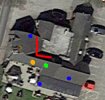Big Jim
Well-Known Member
- Reaction score
- 183
- Location
- Derbyshire, UK
Business is a pub, card payments are taken via wireless terminals (the bases can be hard wired)
Internet is provided by starlink.
getting over 100mbps wired and a good 70/80 wireless
when I arrived the starlink router was in an upstairs room, with wires trailing across the floor to the middle of another room to a spot that gave them wifi signal in the main part of the bar, but poor coverage elsewhere.
on Friday/Saturday I have installed 2 Unifi UAP-AC-Pro in the bar/dining room downstairs, and and AP-AC-M outside.
about 10 minutes after we switched the card payment terminal over to the new SSID I created they were getting random long processing times on the machine, around 30s to a minute after inputting the amount, then the same again once the customer had paid.
I tried switching over to 4G and to wired, and also back to the original starlink SSID, and they all seemed to resolve the issue for 10/15 minutes then it came back again. however 4G signal is poor in the area
Whilst I was onsite I monitored this for around 30 - 45minutes and it seemed completely random, sometimes payment would be pretty much instantaneous, othertimes having the problem above.
but able to browse the internet/ youtube just fine on my phone.
I thought perhaps it was a coincidental issue with the payment processor that would resolve itself, so I just called the customer back and they said they have spoken to dojo who have checked the payment terminals over and they are up to date and all fine, but the payments are still slow.
payment terminal link below, it is running on android.
 dojo.tech
dojo.tech
my next plan of attack is to turn off the unifi APs completely and move the starlink router back to where it was and see if the issue resolves itself.
Internet is provided by starlink.
getting over 100mbps wired and a good 70/80 wireless
when I arrived the starlink router was in an upstairs room, with wires trailing across the floor to the middle of another room to a spot that gave them wifi signal in the main part of the bar, but poor coverage elsewhere.
on Friday/Saturday I have installed 2 Unifi UAP-AC-Pro in the bar/dining room downstairs, and and AP-AC-M outside.
about 10 minutes after we switched the card payment terminal over to the new SSID I created they were getting random long processing times on the machine, around 30s to a minute after inputting the amount, then the same again once the customer had paid.
I tried switching over to 4G and to wired, and also back to the original starlink SSID, and they all seemed to resolve the issue for 10/15 minutes then it came back again. however 4G signal is poor in the area
Whilst I was onsite I monitored this for around 30 - 45minutes and it seemed completely random, sometimes payment would be pretty much instantaneous, othertimes having the problem above.
but able to browse the internet/ youtube just fine on my phone.
I thought perhaps it was a coincidental issue with the payment processor that would resolve itself, so I just called the customer back and they said they have spoken to dojo who have checked the payment terminals over and they are up to date and all fine, but the payments are still slow.
payment terminal link below, it is running on android.
Card machines that take fast reliable payments | Dojo
See our full range of Wi-Fi and 3G/4G enabled card machines with sleek 5-inch touchscreens and Apple and Google Pay as standard.
 dojo.tech
dojo.tech
my next plan of attack is to turn off the unifi APs completely and move the starlink router back to where it was and see if the issue resolves itself.

